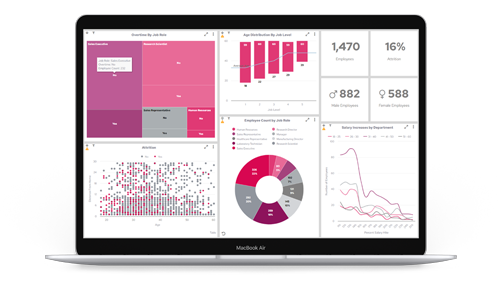Key takeaways
- What data analytics is and why its important
- The process and stages involved in data analysis, including data collection, cleaning, transformation, and analysis.
- The different types of data analysis—descriptive, diagnostic, predictive, and prescriptive—and their unique purposes and applications.
- Various data analysis techniques and tools that organizations can use
What is data analytics?
Data analytics is the process of examining types of data to draw conclusions. It involves looking at raw data to find patterns, trends, and relationships, which helps in making informed decisions and guiding strategies in various fields.
Data analysis increasingly depends on advanced systems and software to optimize its different phases, including data collection, data cleaning, data transformation, and data modeling. These phases are essential for producing precise and dependable insights. For instance, data cleaning removes errors and inconsistencies, whereas data modeling organizes the data for efficient analysis. Both the business sector and scientific communities use these technologies and methods to make well-informed decisions and to confirm or refute scientific theories and hypotheses.
Why is data analytics important?
Data analytics plays a vital role in contemporary organizations by converting raw data into practical insights, which support informed decision-making and strategic planning. Utilizing data analysis allows companies to streamline operations, improve customer experiences, and encourage innovation.
Types of data analytics
Data analysis can be categorised into four main types: descriptive, diagnostic, predictive, and prescriptive analytics. Each type serves a distinct purpose and provides unique insights, helping organisations to make well-informed decisions.

Descriptive analytics
Concentrating on summarizing past data to comprehend historical events. It employs methods like data aggregation and data mining to reveal trends and patterns. For instance, a retailer could utilize descriptive analytics to examine sales data and detect seasonal trends.
Diagnostic analytics
Examines the reasons behind past outcomes. It employs techniques like drill-down, data discovery, and correlations to uncover the root causes of specific events. For instance, a healthcare provider might use diagnostic analytics to determine why there was a sudden increase in patient admissions.
Predictive analytics
Employs statistical models and machine learning techniques to predict future occurrences by analyzing past data. This form of analytics is extensively utilized across different sectors, including finance for credit scoring and marketing for customer segmentation. Predictive analytics enables organizations to foresee upcoming trends and behaviors.
Prescriptive analytics
Provides recommendations for actions to achieve desired outcomes. It combines insights from descriptive, diagnostic, and predictive analytics to suggest the best course of action. For example, a logistics company might use prescriptive analytics to optimise delivery routes and reduce costs.
Data analysis methods
Data analysis encompasses a wide array of techniques, each tailored to specific objectives and applications. Below, we delve into some of the most frequently employed methods:
Exploratory analysis
This technique involves examining data sets to uncover initial patterns, spot anomalies, and test hypotheses. It is often the first step in data analysis, providing a foundation for more detailed investigations.
Regression analysis
Used to understand relationships between variables, regression analysis helps in predicting outcomes and identifying trends. It is particularly useful in forecasting and determining the impact of one variable on another.
Monte Carlo simulation
This method uses random sampling and statistical modeling to estimate mathematical functions and mimic the operation of complex systems. It is widely used in risk assessment and decision-making processes.
Factor analysis
A technique that reduces data complexity by identifying underlying factors that explain the patterns observed in the data. It is commonly used in fields like psychology and market research to identify latent variables.
Cohort analysis
This approach involves studying the behaviors and characteristics of specific groups (cohorts) over time. It is particularly useful in understanding customer retention, user engagement, and lifecycle events.
Cluster analysis
This method groups data points into clusters based on their similarities. It is often used in market segmentation, image processing, and pattern recognition to identify distinct groups within a data set.
Time series analysis
Focused on analyzing data points collected or recorded at specific time intervals, this technique is essential for forecasting and understanding temporal trends. It is widely used in economics, finance, and meteorology.
Sentiment analysis
This technique involves analyzing text data to determine the sentiment expressed within it, whether positive, negative, or neutral. It is commonly used in social media monitoring, customer feedback analysis, and brand reputation management.
How is data analytics used? Data analytics examples
Data analytics helps businesses boost profits, enhance operations, optimize marketing, and improve customer satisfaction. It includes exploratory data analysis (EDA) for pattern recognition and confirmatory data analysis (CDA) for hypothesis testing. Data analytics can be quantitative, focusing on numerical data, or qualitative, examining non-numerical data like text, images, audio, and video to identify themes and viewpoints.
Here are some examples of data analytics applications utilizing these techniques and methods:
Business Intelligence (BI) and embedded analytics
Companies use BI tools or embedded analytics to analyze business data and make informed decisions. This involves using EDA to identify trends and patterns in sales data, customer behavior, and market conditions, followed by CDA to validate these findings and predict future trends.
Healthcare analytics
In healthcare, data analytics is used to improve patient outcomes and operational efficiency. EDA helps identify patterns in patient data, such as common symptoms and treatment outcomes, while CDA tests hypotheses about the effectiveness of different treatments.
Marketing analytics
Marketers use data analytics to understand consumer behavior and optimize campaigns. EDA explores data from various channels like social media, email, and web traffic, while CDA determines the success of marketing strategies and predicts customer responses.
Financial analytics
Data analysis plays a crucial role in risk management, fraud detection, and customer segmentation. Financial institutions leverage predictive analytics to assess the probability of future claims and personalize financial services for their clients. This enables them to make informed decisions and provide tailored services that meet the specific needs of different customer segments. Additionally, EDA uncovers patterns in transaction data, while CDA assesses the validity of financial models and forecasts, further optimizing investment strategies.
Supply chain analytics
Companies use data analytics to enhance supply chain efficiency and reduce costs. EDA identifies bottlenecks and inefficiencies in the supply chain, while CDA tests the impact of different optimization strategies.
The data analytics process: Step-by-step
The data analytics process is a systematic method aimed at converting raw data into valuable insights. This thorough approach encompasses several stages, each crucial for guaranteeing the precision and pertinence of the end results. From setting clear goals to skillfully conveying findings through data storytelling, every phase is integral to the process.

Step 1: Defining the business problem
The initial step involves clearly articulating the problem you aim to solve or the question you seek to answer. This requires a thorough understanding of the business context, the objectives of your analysis, and the key metrics that will gauge success.
Step 2: Data collection
Once the problem is defined, the next step is to collect the data that will be used in the analysis. This can involve gathering data from various sources, such as databases, spreadsheets, and external data sources. It is important to ensure that the data is relevant, accurate, and complete.
Step 3: Data cleansing
Raw data is frequently messy, riddled with errors, missing values, and inconsistencies. Data cleaning is the critical process of identifying and rectifying these issues to ensure the data's accuracy and reliability. This step is indispensable for generating valid and meaningful results.
Utilizing ETL (Extract, Transform, Load) or ELT (Extract, Load, Transform) processes can significantly enhance the efficiency and effectiveness of data cleaning. Furthermore, maintaining high data quality is paramount for making informed decisions and achieving successful outcomes. High-quality data serves as the foundation for insightful analysis, enabling organizations to drive strategic initiatives and optimize performance.
Step 4: Exploratory Data Analysis (EDA)
Once the data is cleaned, the next crucial step is Exploratory Data Analysis (EDA). EDA involves leveraging statistical and visualization techniques to delve into the data, uncovering patterns, trends, and relationships. This process not only enhances your understanding of the data but also helps identify any potential issues or anomalies that may need to be addressed. Various tools and software, such as Python, R, Excel, and specialized platforms like SPSS and SAS, can be employed to perform EDA effectively.
Step 5: Data interpretation
In this step, we focus on transforming complex data into easily interpretable visual formats. By applying various statistical and machine learning models, such as regression analysis, classification, and clustering, we can make predictions, identify patterns, and uncover valuable insights.
Step 6: Data validation
Once the models have been developed, it is important to validate their accuracy and reliability. This involves testing the models on new data and comparing the results to the actual outcomes. This step helps to ensure that the models are robust and can be trusted to make accurate predictions.
Step 7: Data visualization and storytelling
The final step is to present the results of the analysis in a clear and compelling way. This can involve creating charts, graphs, and dashboards to visualize the data and to communicate the key findings to stakeholders. Effective communication is crucial for ensuring that the insights are understood and acted upon.
Data analytics tools
A variety of tools exist to meet diverse requirements, complexities, and skill levels. These tools include programming languages such as Python and R, as well as visualization software like Panintelligence. Let's explore some of these tools further.
Microsoft Excel
Excel is a software program that enables you to organize, format, and calculate data using formulas within a spreadsheet system.
Around for decades, this tool can run basic queries and to create pivot tables, graphs, and charts. Excel also features a macro programming language called Visual Basic for Applications (VBA). Some common uses of Microsoft Excel in data analysis include:
- Data cleaning and preparation
- Statistical analysis
- Formulae and functions
- Pivot tables
SQL
Structured Query Language (SQL) serves as the standard language for managing relational database management systems (RDBMS). It is utilized to efficiently handle, manipulate, and query data stored within databases.
SQL is among the numerous query languages available. Notable versions of SQL include MySQL, PostgreSQL, and Oracle SQL. Although there are some distinctions between these variants, they generally adhere to comparable syntax and principles. SQL is frequently employed in data analysis for several purposes, such as:
- Data querying
- Data manipulation
- Data aggregation
- Database management
Panintelligence
Panintelligence is a robust data analytics and visualization tool that equips users with dynamic and visually appealing dashboards, embedded directly into your application. The user-friendly no/low-code interface is designed for both experts and novices, allowing non-technical users to effortlessly create insightful data visualizations.
One of the platform's most notable features is its strong ability to handle complex and large datasets while providing real-time analytics. This enables users to make well-informed decisions based on the latest data.

Key features of Panintelligence include:
- Fully customisable white label dashboarding, reporting and predictive analytics
- Data exploration and discovery
- Numerous integrations
- Real-time analytics
Conclusion
Data analytics enables people and businesses to effectively utilize their data in an era where information and statistical collection are becoming ever more crucial. By applying various tools and methods, raw data can be converted into valuable, insightful information that informs decision-making and strategic management.






















